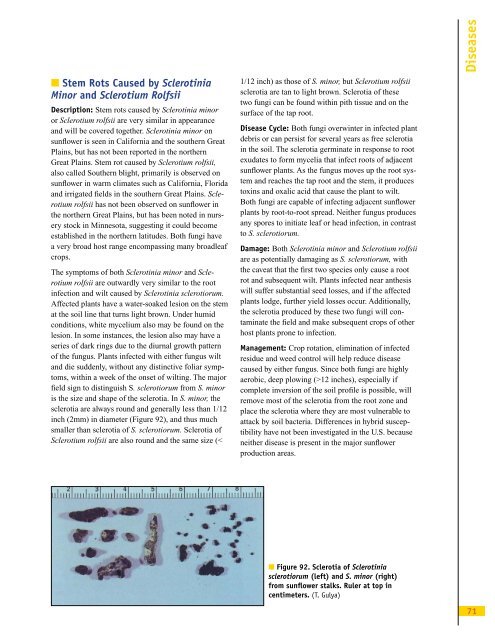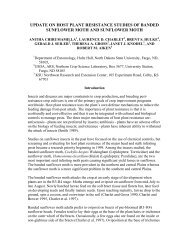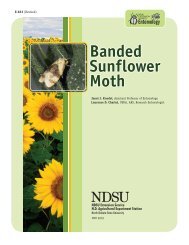Thus, lower plant populations will facilitate more airmovement and hasten leaf drying. Moderate levelsof nitrogen fertilization also will minimize excessivefoliage, but this needs to be counterbalanced withadequate fertilization to optimize yields.■ Figure 91. Apothecia in field of soybean plants.(B.D. Nelson)tissue. Midstalk infection may result from either leafinfection or infection at the leaf axil. Head infectionactually starts as ascospores colonize the dead floretsand pollen on the face of the head. Thus, when lesionsare seen on the back of the head, several weeks haveelapsed since infection took place.Damage: Middle stalk rot is the least often seen phaseof Sclerotinia diseases. Head rot incidence fluctuatesdramatically, dependent entirely upon weather conditions.In dry years, head rot is entirely absent, while inyears and locations where rainfall is frequent duringand after flowering, head rot may be present in nearlyall fields to some degree. Currently the incidence ofhead rot and wilt in the <strong>Dakota</strong>s is about equal, withapproximately 3 percent of the crop affected by eachdisease. Yield loss from head rot on an individualplant may range from minimal to total loss since theaffected head may disintegrate and drop all of the seedon the ground prior to harvest. Intact but diseasedheads will have light and fewer seeds, with lower oilconcentration, and also will shatter during harvest.The sclerotia that form in the diseased stalks andheads are returned to the soil at harvest, thus contaminatingthe field for subsequent broadleaf crops.Management: The same comments made about Sclerotiniawilt also apply to head rot management, withsome exceptions. Since ascospores that cause headrot can be blown into a field, rotation will have lessconsistent impact upon head rot, even though it mayreduce the levels of sclerotia in the field. Anythingthat can minimize the crop canopy will help modifythe environment necessary for ascospore infection.One of the most important tools for managing allSclerotinia diseases is monitoring the incidence ofSclerotinia diseases on any preceding crop. If Sclerotiniais observed on a crop, the grower then knowsthat planting any susceptible crop in that field thenext year is imprudent. The number of years necessaryto rotate away from susceptible broadleaf crops(while the population of sclerotia declines) dependsupon the initial Sclerotinia incidence. As a generalrule of thumb, most researchers suggest that fouryears away from broadleaf crops should reduce thesclerotial population to below a threshold level. Sincesunflower is the only crop prone to root infection, androot infection can happen even in dry years, sunflowerobviously would be the worst crop choice to plant ina known infested field, with dry bean and canola followingclosely behind. As stated earlier, the best cropsto break the Sclerotinia cycle are monocots (smallgrains, corn, sorghum).<strong>Sunflower</strong> hybrids do exhibit different degrees of susceptibilityto head rot, but no totally resistant hybridsare available. An extensive testing program is underway to evaluate commercial hybrids for head rot resistance.Several university research centers have establishedmist-irrigated plots, which when coupled withartificial inoculations with ascospores, have producedhigh levels of infection to accurately assess hybriddisease response. After the most resistant hybrids havebeen tested in multiple locations, this information willbe published in the <strong>NDSU</strong> publication “Hybrid <strong>Sunflower</strong>Performance Testing” (A652), also availableonline at www.ag.ndsu.edu/pubs/plantsci/rowcrops/a652.pdf. No chemical is registered for control of headrot in the U.S. Even if a chemical were registered, itwould have to be applied as a preventative becausewhen symptoms become visible, the infection alreadytook place two to three weeks earlier and the fungushas become well-established in the head.For more information on sclerotinia, consult <strong>NDSU</strong>Extension Service publication “Sclerotinia Diseaseof <strong>Sunflower</strong>” (PP-840), also viewable on the Internetat www.ag.ndsu.edu/pubs/plantsci/rowcrops/pp840w.htm.70
■ Stem Rots Caused by SclerotiniaMinor and Sclerotium RolfsiiDescription: Stem rots caused by Sclerotinia minoror Sclerotium rolfsii are very similar in appearanceand will be covered together. Sclerotinia minor onsunflower is seen in California and the southern GreatPlains, but has not been reported in the northernGreat Plains. Stem rot caused by Sclerotium rolfsii,also called Southern blight, primarily is observed onsunflower in warm climates such as California, Floridaand irrigated fields in the southern Great Plains. Sclerotiumrolfsii has not been observed on sunflower inthe northern Great Plains, but has been noted in nurserystock in Minnesota, suggesting it could becomeestablished in the northern latitudes. Both fungi havea very broad host range encompassing many broadleafcrops.The symptoms of both Sclerotinia minor and Sclerotiumrolfsii are outwardly very similar to the rootinfection and wilt caused by Sclerotinia sclerotiorum.Affected plants have a water-soaked lesion on the stemat the soil line that turns light brown. Under humidconditions, white mycelium also may be found on thelesion. In some instances, the lesion also may have aseries of dark rings due to the diurnal growth patternof the fungus. Plants infected with either fungus wiltand die suddenly, without any distinctive foliar symptoms,within a week of the onset of wilting. The majorfield sign to distinguish S. sclerotiorum from S. minoris the size and shape of the sclerotia. In S. minor, thesclerotia are always round and generally less than 1/12inch (2mm) in diameter (Figure 92), and thus muchsmaller than sclerotia of S. sclerotiorum. Sclerotia ofSclerotium rolfsii are also round and the same size (12 inches), especially ifcomplete inversion of the soil profile is possible, willremove most of the sclerotia from the root zone andplace the sclerotia where they are most vulnerable toattack by soil bacteria. Differences in hybrid susceptibilityhave not been investigated in the U.S. becauseneither disease is present in the major sunflowerproduction areas.Diseases■ Figure 92. Sclerotia of Sclerotiniasclerotiorum (left) and S. minor (right)from sunflower stalks. Ruler at top incentimeters. (T. Gulya)71










